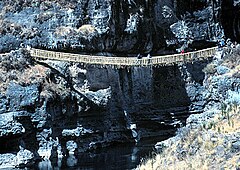Inca rope bridge

The annually reconstructed Q'iswa Chaka ("rope bridge") in the Quehue District is the last of its kind.
|
|
| Ancestor | Rope bridge |
|---|---|
| Related | None |
| Descendant | Simple suspension bridge |
| Carries | Pedestrians, |
| Span range | Short |
| Movable | No |
| Design effort | Advanced for its time |
| Falsework required | No |
Inca rope bridges are simple suspension bridges over canyons and gorges and rivers (pongos) constructed by the Inca Empire. The bridges were an integral part of the Inca road system and exemplify Inca innovation in engineering. Bridges of this type were useful since the Inca people did not use wheeled transport - traffic was limited to pedestrians and livestock - and they were frequently used by Chasqui runners delivering messages throughout the Inca Empire.
The Incas used natural fibers found within the local vegetation to build bridges. These fibers were woven together creating a strong rope and were reinforced with wood creating a cable floor. Each side was then attached to a pair of stone anchors on each side of the canyon with massive cables of woven grass linking these two pylons together. Adding to this construction, two additional cables acted as guardrails. The cables which supported the foot-path were reinforced with plaited branches. This multi-structure system made these bridges strong enough to even carry the Spaniards while riding horses, after they arrived. The design naturally sags in the middle.
Part of the bridge's strength and reliability came from the fact that each cable was replaced every year by local villagers as part of their mit'a public service or obligation. In some instances, these local peasants had the sole task of maintaining and repairing these bridges so that the Inca highways or road systems could continue to function.
Repairing these bridges was dangerous, as those performing repairs often met death. An Inca author praised Spanish masonry bridges being built, as this rendered the need to repair the rope bridges moot.
The greatest bridges of this kind were in the Apurímac Canyon along the main road north from Cusco; a famous example spans a 148-foot gap that is supposed to be the inspiration behind Thornton Wilder's 1928 Pulitzer Prize winning novel The Bridge of San Luis Rey (1927).
...
Wikipedia
